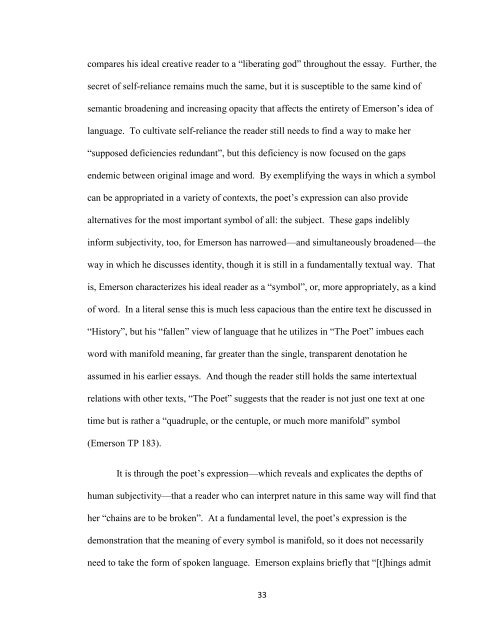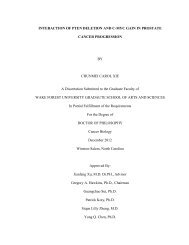RALPH WALDO EMERSON AND THE EVER-EVOLVING ART OF ...
RALPH WALDO EMERSON AND THE EVER-EVOLVING ART OF ...
RALPH WALDO EMERSON AND THE EVER-EVOLVING ART OF ...
You also want an ePaper? Increase the reach of your titles
YUMPU automatically turns print PDFs into web optimized ePapers that Google loves.
compares his ideal creative reader to a “liberating god” throughout the essay. Further, the<br />
secret of self-reliance remains much the same, but it is susceptible to the same kind of<br />
semantic broadening and increasing opacity that affects the entirety of Emerson’s idea of<br />
language. To cultivate self-reliance the reader still needs to find a way to make her<br />
“supposed deficiencies redundant”, but this deficiency is now focused on the gaps<br />
endemic between original image and word. By exemplifying the ways in which a symbol<br />
can be appropriated in a variety of contexts, the poet’s expression can also provide<br />
alternatives for the most important symbol of all: the subject. These gaps indelibly<br />
inform subjectivity, too, for Emerson has narrowed—and simultaneously broadened—the<br />
way in which he discusses identity, though it is still in a fundamentally textual way. That<br />
is, Emerson characterizes his ideal reader as a “symbol”, or, more appropriately, as a kind<br />
of word. In a literal sense this is much less capacious than the entire text he discussed in<br />
“History”, but his “fallen” view of language that he utilizes in “The Poet” imbues each<br />
word with manifold meaning, far greater than the single, transparent denotation he<br />
assumed in his earlier essays. And though the reader still holds the same intertextual<br />
relations with other texts, “The Poet” suggests that the reader is not just one text at one<br />
time but is rather a “quadruple, or the centuple, or much more manifold” symbol<br />
(Emerson TP 183).<br />
It is through the poet’s expression—which reveals and explicates the depths of<br />
human subjectivity—that a reader who can interpret nature in this same way will find that<br />
her “chains are to be broken”. At a fundamental level, the poet’s expression is the<br />
demonstration that the meaning of every symbol is manifold, so it does not necessarily<br />
need to take the form of spoken language. Emerson explains briefly that “[t]hings admit<br />
33




